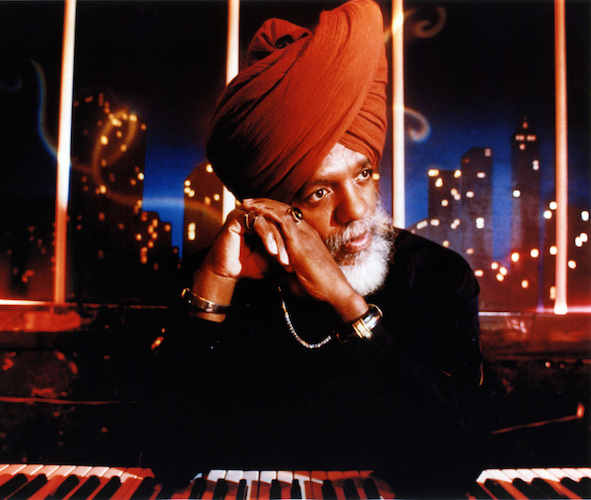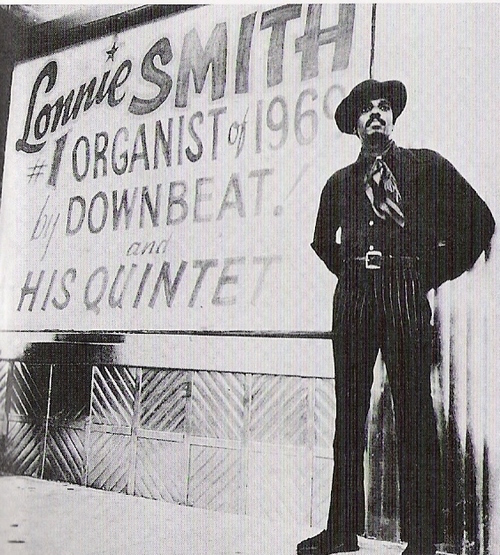Music Interview: Talking to Organist Dr. Lonnie Smith — Soul-Jazz Legend
Jazz organ pioneer Dr. Lonnie Smith comes to the Rockport Jazz Festival.

Dr. Lonnie Smith, jazz organist extraordinaire. Photo: Susan Stocker/Sun-Sentinel.
By Noah Schaffer
The soul-jazz organ revival of the late 90’s seems to have petered out. But it’s had at least one lasting benefit: It launched a comeback by Dr. Lonnie Smith that is still going strong.
At 74, Smith is one of the last survivors of the golden era of ’60s soul-jazz, a time when Hammond B-3 organists were a predictable presence both on the charts and at neighborhood lounges. Smith was discovered along with guitarist George Benson in upstate New York, and in 1967 joined saxophonist Lou Donaldson for the classic Blue Note LP Alligator Boogaloo. Soon Smith was putting out his own Blue Note LPs. His memorable long beard and turban was matched by a distinctive brand of wild playing, that, according to a Keyboard Magazine article, would see him “slap and stab” at the organ and utilize “snake charmer” music and Hungarian scales.
These days Smith enjoys the life of a jazz legend. The small joints he used to gig at have been replaced by major festivals and rarefied halls like the acoustically perfect Shalin Liu Performance Center in Rockport, MA, where he performs on Saturday as part of the Rockport Jazz Festival. This year he released his first Blue Note LP in 45 years, Evolution, and he has been named a 2017 National Endowment for the Arts JazzMaster.
Smith spoke to Arts Fuse from his longtime Ft. Lauderdale home.
Arts Fuse: In recent yours you’ve toured and recorded with some larger bands, but in Rockport you’ll be with the classic Hammond B-3 jazz organ format with guitar and drums. What about that combination has made it so durable?
Dr. Lonnie Smith: Yes, I’ll have Jonathan Kreisberg on guitar and Joe Dyson on drums. I’ve been playing with them since they were really young — hey, everybody I play with is young to me! Playing with a trio is something I love in a lot of ways because you have more space to create. I like listening to other musicians and I want to hear them. I don’t like to put people in my band just to sit in the background, I want them to be heard. If I don’t know how I sound by now I’ll never know how I sound! The space created by the trio forces me to be creative. I can go where I want to go quickly and change things up all the time. No one can sit back and relax. They have to watch and listen and carry on that way because I’ll say something and they’ll respond, then they’ll say something and I’ll respond. I love that feeling! I don’t like it when everything is written out and played perfectly — after a while it gets boring.

AF: Your new album opens with tracks that you first recorded in the ’70s, “Afro Desia” and “Play It Back.” What made you want to revisit them?
Smith: People ask me all the time about songs that they can’t get anymore, since today record companies come and go. Now Blue Note is not going anywhere, so I tried to squeeze in something that the young people might have missed. On “Afro Desia” I had Joe Lovano who used to play with me years ago. So it made sense. I also had Robert Glasper and he wasn’t there at the time but he fit right in. It gave it a new spin.
AF: Robert Glasper has done a lot to bridge the jazz and hip-hop worlds. And on that note, you’re one of the most sampled jazz artists. What’s it like hearing your music sampled by hip-hop artists?
Smith: It’s great because they hear something that they enjoy and can turn it into something they can play their way. So they bring another new twist to it. When I hear it I don’t know what happened, but now even my kids will rap to my music and it’s perfect for that! It fits so great. Now rap is not something new to me. Back in the day you had Lou Rawls, you had all the blues singers, they were rapping, they talked. They didn’t call it rap but they talked and told a story while the music was playing, and also don’t forget the churches. The preachers always told a story with music is playing in the background.
AF: You’re a self-taught musician who works with a lot of younger musicians who were taught jazz at music schools. Has does being self-taught influence your approach to improvising?
Smith: It’s a little different — it encourages me to experiment, it doesn’t hold me tight and block me into a situation. I don’t have to worry ‘oh that’s not the right chord ‘ — there are substitutions and those substitutions can work! if you put on a 7th cord on the top or bottom or middle — well I don’t know where the 7th is, so what’s the difference? I can sing and harmonize it, so I can do that. I know harmony in my head. I play some songs and someone might say “how dare he” — and now the song becomes mine. But then you can play the same song tomorrow and it won’t sound that good, so I’m never satisfied.
AF: Let’s talk a bit about your early career. Is the story that you and George Benson were discovered playing with go-go dancers true?

Dr. Lonnie Smith in the early ’70s. Photo: drlonniesmith.com
Smith: You’ve got to imagine! Put your thinking cap on and picture it. We were two bad cats. There was a go-go girl on top of the organ speaker! When [famed record executive] John Hammond came in we told the girls to get down for a few minutes so we could play some tunes. He wanted to sign us on the spot.
I had only been playing [organ] a little over a year. I was blessed. I had been playing behind Dionne Warwick, Gladys Knight, the Impressions. We are surrounded by angels. I lot of people don’t realize that. Some of my angels were my school teacher Mazie Campbell, my first manager when I went on the road, Jimmy Boyd, and Art Kubera, who owned a record store and gave me my first organ. He GAVE it to me. It cost thousands of dollars even then. Can you believe it? I didn’t have any money. I’d go sit in his store every day. He knew if I played it I could make a living. He passed about a year ago. He watched my whole career and I never let him down.
AF: You lived in South Florida for many years. Was it hard sustaining a jazz career outside of New York?
Smith: Can I tell you the truth? I’m still in Florida! It can be very hard. But it’s very quiet here. It’s hot outside so I just stay in my house. I have the air conditioner really cold and the fan is going and blowing my beard all over the place. A lot of my [musical] family is in New York. We are close, so I miss that kind of surrounding. It’s not like you can just go holler at your friend because they’re playing close by. So you see other musicians on the road. But my neighborhood is great. You ever see the movie Stepford Wives? It’s like that – neighbors might bring something to my door, food or something. Everybody is really nice.
AF: If I can end on a superficial note, when did you first start wearing your trademark turban?
Smith: I knew what that question was going to be! The turban, is it religious – I don’t need to talk about it. [My music] definitely speaks for itself. Playing the music and the organ is like a flame, it’s like a fire, it’s electricity that goes through my body. That’s what I feel and I hope the people feel that. The organ is an extension of my body. Now I should warn people that last week I was in New Mexico with its high altitude and I got a bit light headed and fell. I busted my head wide open — it looked as if I’d been in a fight with Ali! So if I look a bit banged up, don’t throw your shoes at the stage.
Over the past 15 years Noah Schaffer has written about otherwise unheralded musicians from the worlds of gospel, jazz, blues, Latin, African, reggae, Middle Eastern music, klezmer, polka and far beyond. He has won over ten awards from the New England Newspaper and Press Association.
